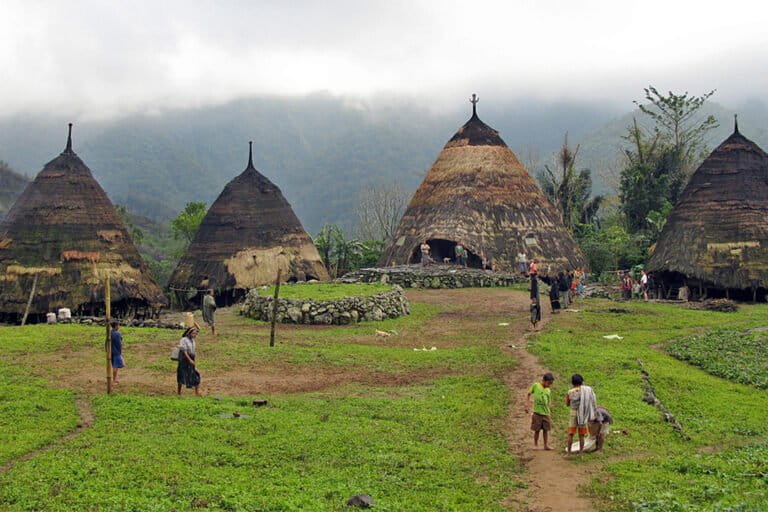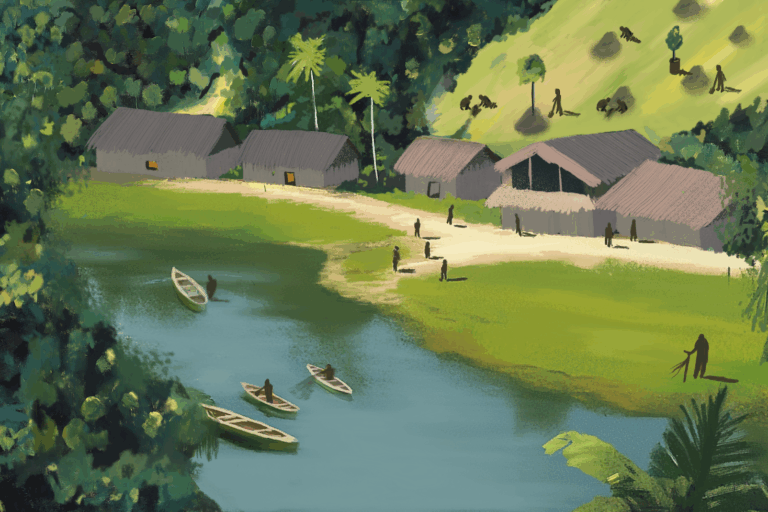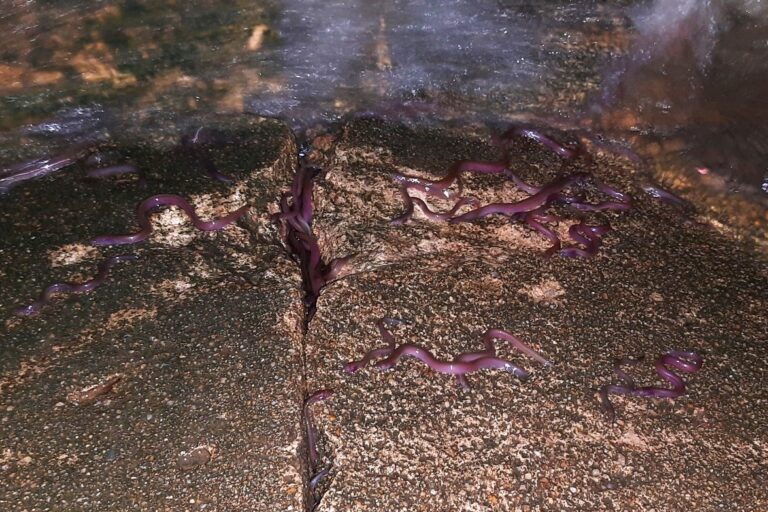- Southeast Asia’s Mekong giant catfish (Pangasianodon gigas) is the world’s largest freshwater fish, with the biggest among them weighing an astonishing 650 pounds (300 kilograms), and growing to a length of 10 feet (3 meters).
- Species numbers are thought to have crashed by 80 percent in recent decades, although there are no reliable population estimates for the fish. A sudden escalation in the construction of hydroelectric dams on the Mekong could seal the fate of the species.
- A host of dams, both under construction and planned, threaten to block the catfish’s natural migration patterns, potentially driving it to extinction. The Xayaburi dam, which is already being built, poses the most immediate threat.
- Radio telemetry and environmental DNA techniques are crucial to the study and monitoring of this elusive creature in the wild. Conservationists working at Cambodia’s proposed Sambor Dam hope to help the government design a project that might vastly improve aquatic connectivity.

Humanity rarely seems to get very excited about conserving fish species, maybe because they are largely invisible to us land-dwelling creatures — except when they arrive on a dinner plate. But if any fish is deserving of a spot on the Almost Famous Asia list of threatened animals, it is the Mekong giant catfish (Pangasianodon gigas).
P. gigas is the world’s largest freshwater fish, with the biggest individuals weighing in at a remarkable 650 pounds (300 kilograms) and reaching up to 10 feet (3 meters) in length. They are found throughout the length of Southeast Asia’s Mekong River, and their health is inextricably linked to the health of the river itself.
Sadly, the prognosis isn’t good. The giant catfish’s population is thought to have crashed by 80 percent in recent decades. The species is listed as Critically Endangered by the IUCN, but no one really knows how many survive in the Mekong today. And future development on the river doesn’t bode well.
As goes the Mekong River, so goes the giant catfish
“As one of the largest freshwater fish on earth, [the Mekong giant catfish] is symbolic of the integrity and health of the Mekong River”, says Zeb Hogan, an ecologist with the University of Nevada in Reno, who has been studying the species for nearly 20 years. “In a river like the Mekong, the largest fish disappear first, so the decline of the Mekong giant catfish is an early warning sign of overfishing and other problems in the environment”, he explains.

Although the Mekong is not as famous as the species-rich Amazon River, this Southeast Asian stream supports more than 1,200 described species of fish, and is a biodiversity hotspot that rivals the great South American river.
But the Mekong and its aquatic species are enduring a myriad of interrelated threats, ranging from dams and overfishing, to pollution and climate change.
One of the biggest underlying problems is the growing human population in Southeast Asia, which puts pressure on the entire Mekong watershed. Pressure to feed more people leads to overfishing, while increasing wealth means people eat more, furthering the problem. Feeding an exploding population also leads to agricultural expansion and competition over the Mekong’s limited water resources, as well as increased pollution from pesticides, fertilizers and animal waste.
Too many people fishing, not enough fish
Overfishing is a major issue for inland waterways globally, and the hallmarks of an escalating crisis are clear in Mekong fishery statistics. The number of people fishing on Tonle Sap Lake — an ecologically critical part of the Mekong Basin — for example, has soared from 360,000 individuals in 1940 to an astonishing 1.3 million in 1995.
Over that time, the catch per individual was cut in half. The type of catch changed too; in the past people caught predominantly large fish, but small fish dominate the Tonle Sap catch today, indicating that mature adult fish have largely been removed from the population.

“Freshwater ecosystems are incredibly important to the health and wellbeing of both people and wildlife, but are also among the most threatened ecosystems in the world”, notes Erin Loury, Fisheries Biologist at FISHBIO and member of the Mekong Fish Network.
Climate change is also generating impacts across the region, with reduced rainfall and increases in water temperatures already being reported. Exacerbated by the most recent El Niño, Vietnam saw severe drought in 2015 and early 2016, which led to the Mekong Delta reaching its lowest recorded level in 100 years. Neighboring Cambodia and Thailand have also experienced extreme heat waves and water shortages, forcing China to open the gates of its Mekong dams to provide more water to countries downstream in the Mekong Basin.
All of these issues threaten not only the Mekong giant catfish, but also the millions of people across Southeast Asia that rely on the river for their lives and their livelihood. “The Mekong River is the most productive river on Earth and supports over 70 million people”, emphasizes Hogan. Their fate, and that of the Mekong giant catfish, depends on how we manage the development of the Mekong River.
The rush to dam the Mekong
Dams may be the single biggest threat to the Mekong ecosystem, and to the migratory giant catfish. Governments and the populace of Southern Asia increasingly want to get away from heavily polluting fossil fuels for their energy needs, and they see hydropower as an attractive and viable alternative.
The government of the Lao People’s Democratic Republic (PDR) has declared its ambition to become the “battery of Southeast Asia”, and the Mekong certainly holds sufficient “battery power” to achieve that. The estimated hydropower potential of the entire Mekong Basin is 53,000 Megawatts (MW) — over a third of the energy needs projected by 2025 for Cambodia, Lao PDR, Thailand and Vietnam combined.

There are six dams already in place on the Upper Mekong in China, with the capacity to harness around 11,000 MW of the river’s energy. A further two dams are currently under construction downstream in Laos, and there are at least 27 more planned along the main stem of the Mekong River, primarily in Laos and China.
The Xayaburi example
While these many proposed dams promise to provide renewable energy for a growing human population across Southeast Asia, they will also have a serious impact on aquatic ecosystems and especially fish.
In 2010, the Laos and Thai governments began work on the Xayaburi mega-dam, expected to produce 1,285 MW. The electricity utility of Thailand, known as EGAT, has agreed to purchase 95 percent of that electricity, but estimates suggest Thailand doesn’t need that much energy to meet its national demand, which means that some of that electricity may be for export.
The project has been vigorously opposed by Cambodia and Vietnam — both downstream of the project — as well as by local and global environmental organizations.
In 2012, villagers from eight provinces in Thailand filed a lawsuit against five government bodies, including EGAT, for their role in building the Xayaburi dam. The suit claimed that the government agencies failed to do an adequate assessment of the health and environmental impacts before the project was approved and began construction.
The court’s final verdict found that the state agencies had complied with Thai law, but this controversial case brought the environmental impact of hydropower on the Mekong to mainstream attention. There are now tremendous concerns among local people that Xayaburi and other planned Mekong dams will worsen seasonal flooding and disrupt fish spawning, ultimately forcing farmers and fisher folk off their lands and out of their livelihoods.
Dams and migratory fish don’t mix
Dams create a physical barrier that can halt fish migrations and spawning up and down river. Between October and December each year, Mekong giant catfish migrate from lakes in the lower Mekong of Vietnam, upstream into Cambodia, Laos and Thailand, where they spawn.

“The catfish are highly migratory”, explains Hogan. Because these annual movements through the watershed are largely unseen, he has used radio telemetry to track and monitor adult catfish migrations throughout the river system. “They move out of the Tonle Sap Lake and into the mainstream Mekong River at the end of the rainy season”, he says. Little is known about the adults’ return migration, but young catfish migrate down river as larvae, following the floodwaters to reach Cambodia in July and August.
A new study published this year provided even more evidence that the Mekong giant catfish is a big league traveler, using the entire length of the river and its habitat to support the species’ lifecycle. Eva Bellemain and her colleagues at SpyGen have utilized environmental DNA to track the catfish’s movement throughout the watershed.
“Environmental DNA (eDNA) is DNA that has been released by an organism into the environment, via feces, hair, urine, skin, gametes, etc.”, Bellemain explains. “This DNA can be extracted from environmental samples such as soil and water” and sequenced to detect that a particular species is present at a particular locale, without ever having to see or catch the animal.
“We identified the DNA from the giant catfish at one location [within] the species’ presumed spawning grounds on the Mekong mainstream, near the border between northern Thailand and Lao PDR”, Bellemain explains. The presence of the catfish’s DNA there tells the researchers that the fish was at that spot quite recently.
“Unfortunately, this site is upstream of the first mainstream dam being constructed on the lower Mekong near Xayaburi”, she says. It remains to be seen whether the Mekong giant catfish will be able to complete its migration and spawn once the Xayaburi dam is completed.

The Xayaburi dam will be the first built downstream of catfish spawning grounds, cutting them off from their annual migration route. “Once the dam has been completed, future eDNA surveys would allow us to see if the known spawning site upstream of the [blocking] infrastructure is still occupied”, giving an indication of whether the catfish can somehow migrate past the dam, explains Bellemain.
The risk to aquatic ecosystems
It’s not just the giant catfish that will be impacted by an explosion of new hydroelectric projects. Many of the Mekong’s fish are thought to be migratory, and scientists have predicted that new dams could block migration routes for up to 100 species, including the Mekong giant catfish. These migratory species are also disproportionately important to local people as food and livelihood — up to 70 percent of commercially important fish in the Mekong are long-distance migrators.
Dams that prevent fish migrations on the main stem Mekong could severely damage catches throughout the basin. Such impacts have already been seen in the Amazon Basin, where dams on the Araguaia-Tocantins River in Brazil have halted long-distance catfish migrations, and have been linked to downstream catch reductions of up to 70 percent.
Dams have other ecological impacts; they interrupt natural flood cycles, and can cause the riverbed to harden. Rapid bursts of water released by dams carry away silt and sediments that provide a home and food source for aquatic plants, invertebrates and fish. Dams also disrupt the natural flow and vital dispersal of sediments throughout river systems, causing a build-up of sediment up-stream, and preventing nutrients from being carried downstream.

Sediment blockage from dams could have major impacts on aquatic systems, and on agriculture in the lower Mekong. Without the normal flow of nutrients from the river, crop yields may drop dramatically, and so might fishery yields. Dams in the Mekong are already being linked to reduced agricultural fertility and disrupted seasonal sediment flow rhythms in the Mekong Delta.
The Xayaburi is just one of many dams that threaten to fragment and degrade the Mekong ecosystem. “Connectivity is one of the most important aspects of a healthy freshwater ecosystem, allowing water, nutrients, and animals to move from one location to another”, says FISHBIO’s Loury. But “thousands of barriers have been built in the Mekong River System that can disrupt these natural processes, and many more are planned.”
Looking forward, finding solutions
The prognosis for the Mekong giant catfish is “not good”, says Hogan bluntly. “With the Xayaburi dam almost complete, the main hope for giant catfish is that they can complete their life cycle in a fragmented river. If they cannot, then they will go extinct in the wild”.
But there might be ways that migratory fish can survive the dams. Some engineers believe it’s possible to harness the hydropower of rivers like the Mekong, without disrupting nutrient cycles and migratory fish.

With that in mind, fish ladders have been installed on some of the Mekong’s newer dams, including Xayaburi, to help migrating fish deal with the challenge of moving past a 33 meter-tall dam (more than 100 feet). The Xayaburi dam’s proponents claim these “fishways” will allow migratory species to safely travel upstream and down.
But while fish ladders have had some success in North America, studies show that they are only effective for some species, and are particularly ineffective for slow-swimming fish. In Thailand, The Pak Mun Dam included a fish ladder to enable fish to migrate into the Mun River. The fish ladder was completely ineffective, and less than ten years after the dam was completed, successful campaigning led the government to permanently open the dam gates in order to safeguard the fishery.
“It is not possible to build a dam that has no ecosystem impacts”, explains Tom Wild, a Postdoctoral Fellow in Civil and Environmental Engineering at Cornell University. “In a river basin like the Mekong, where human well-being is so intimately connected with the health and productivity of the river”, Wild says, “it is all the more important … to identify dams that offer some balance” between growing energy demands and the need for a healthy, functioning ecosystem.
Wild is part of a Natural Heritage Institute team that is working in partnership with the National Government of Cambodia to develop “an ecosystem-energy balance for the Sambor Dam”. This Cambodian project, currently in the planning stages, will be the farthest downstream dam proposed for the main stem of the Mekong — making its likely impact on fish migration and sediment movement particularly important for the overall health of the river.

“Sambor Dam would be sited on top of one of the world’s largest fish migration corridors, and would be the last dam to be sited upstream of one of the world’s most productive lakes [Tonle Sap] and the Vietnam Delta”, says Wild.
“Our work seeks to identify alternative dam sites, designs and operating policies for Sambor Dam that could significantly improve the flows of water, sediment and fish through and/or around the dam”, he explains.
This is “an immense challenge” Wild concedes, requiring a new way of thinking about dam design. Smaller dams with migration channels can help ensure fish are able to get past a dam. The team is also investigating the feasibility of turbines that could significantly reduce fish mortality, and radial gates that enable sediment flow.
“Avoiding severe fishery impacts will require a fundamental re-thinking to the way dams are sited, designed and operated”, Wild says. Most importantly, these considerations need to be included right from the start of the planning process, before the location and design of a hydroelectric project has been selected.

Wild hopes that Sambor can become a success story pointing the way to alternative river basin infrastructure that preserves ecosystem health and productivity. “The lessons from [this project] would be applicable to other sites within the Mekong and in other basins considering intensive and pervasive hydropower dam development”, he says.
Too little, too late?
These new dam building and siting efforts may not, however, come soon enough for the Mekong giant catfish.
Conservationists are working hard to make the best of a bad situation for the species. The International Union for the Conservation of Nature (IUCN), together with FISHBIO and the World Wildlife Fund (WWF), have worked closely with the Department of Livestock and Fisheries in Laos, as well as with local communities, to develop a series of fish conservation zones (FCZs) across the Mekong. There are now about 1,000 designated FCZs across the country, areas completely closed to fishing. The hope is that these closures will allow fish populations to rebound and will protect vital spawning areas.
Political opinion in parts of Southeast Asia is starting to change too, and government officials increasingly appreciate the devastating changes the people of the Mekong are facing. Earlier this year, The Vietnamese government announced the Mekong Delta Plan — a realistic long-term strategy to help people that rely on the Mekong delta cope with the inevitable changes brought by upstream dams and climate-linked sea-level rise.
Conservationists say that the Mekong giant catfish has the potential to become the Panda of the Mekong River, a poster-child for one of the most important ecosystems on Earth. “The [species] depends on a healthy, functioning river system to survive, so efforts to conserve Mekong giant catfish would also benefit many other species”, Loury contends. “The Mekong giant catfish is like an ambassador that can draw attention to these important freshwater ecosystems”.
“The giant catfish also has great cultural significance for some local cultures”, she adds. “Historically, harvesting a large fish of this size was an act that required cooperation, and brought the community together”.

Another initiative, WWF’s Living Mekong Program, is working in partnership with the Mekong River Commission and the Asian Development Bank to implement policies to protect freshwater habitats and to ensure that aquatic ecosystems needed by local communities are sustained.
Monitoring will also be an important piece of the Mekong giant catfish conservation puzzle. New techniques of surveying for environmental DNA could make large-scale monitoring more feasible. For instance, “eDNA sampling could be used to monitor the fish conservation zones”, explains Bellemain, as well as providing baseline data about the biodiversity of the Mekong River. “Such multi-species approaches have the additional capacity to detect rare and secretive [aquatic] species”, she says.
As promising as these conservation efforts may sound, infrastructure plans on the Mekong seem unstoppable and likely to do serious harm to aquatic habitats, and to migratory fish species. If major projects — such as the already underway Xayaburi dam — fully block key migration routes, extinction may not be far off for the Mekong giant catfish.
As conservationists struggle to respond to each new dam proposal, the sheer speed and scale of development in the Mekong Basin threatens to send the world’s biggest freshwater fish into oblivion.

Review questions for educators
These questions can help provide a framework for exploring topics presented in this story.
- What is the Mekong giant catfish?
- Where does the Mekong giant catfish live?
- Why is the Mekong giant catfish endangered?
- Why is the Mekong giant important local communities along the Mekong River?
- How are conservationists working to protect the Mekong giant catfish from extinction?














